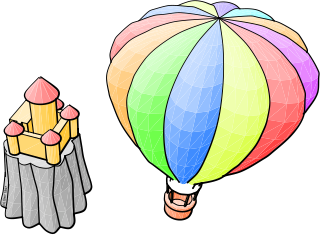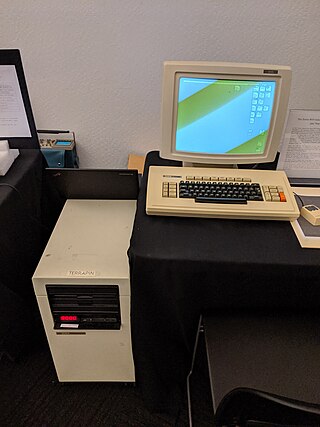Related Research Articles

Alan Curtis Kay is an American computer scientist best known for his pioneering work on object-oriented programming and windowing graphical user interface (GUI) design. At Xerox PARC he led the design and development of the first modern windowed computer desktop interface. There he also led the development of the influential object-oriented programming language Smalltalk, both personally designing most of the early versions of the language and coining the term "object-oriented." He has been elected a Fellow of the American Academy of Arts and Sciences, the National Academy of Engineering, and the Royal Society of Arts. He received the Turing award in 2003.
In object-oriented programming, a class defines the shared aspects of objects created from the class. The capabilities of a class differ between programming languages, but generally the shared aspects consist of state (variables) and behavior (methods) that are each either associated with a particular object or with all objects of that class.

A graphical user interface, or GUI, is a form of user interface that allows users to interact with electronic devices through graphical icons and visual indicators such as secondary notation. In many applications, GUIs are used instead of text-based UIs, which are based on typed command labels or text navigation. GUIs were introduced in reaction to the perceived steep learning curve of command-line interfaces (CLIs), which require commands to be typed on a computer keyboard.

The history of the graphical user interface, understood as the use of graphic icons and a pointing device to control a computer, covers a five-decade span of incremental refinements, built on some constant core principles. Several vendors have created their own windowing systems based on independent code, but with basic elements in common that define the WIMP "window, icon, menu and pointing device" paradigm.

Smalltalk is a purely object oriented programming language (OOP) that was originally created in the 1970s for educational use, specifically for constructionist learning, but later found use in business. It was created at Xerox PARC by Learning Research Group (LRG) scientists, including Alan Kay, Dan Ingalls, Adele Goldberg, Ted Kaehler, Diana Merry, and Scott Wallace.

In the industrial design field of human–computer interaction, a user interface (UI) is the space where interactions between humans and machines occur. The goal of this interaction is to allow effective operation and control of the machine from the human end, while the machine simultaneously feeds back information that aids the operators' decision-making process. Examples of this broad concept of user interfaces include the interactive aspects of computer operating systems, hand tools, heavy machinery operator controls and process controls. The design considerations applicable when creating user interfaces are related to, or involve such disciplines as, ergonomics and psychology.
Cocoa is Apple's native object-oriented application programming interface (API) for its desktop operating system macOS.

The Xerox Star workstation, officially named Xerox Star 8010 Information System, is the first commercial personal computer to incorporate technologies that have since become standard in personal computers, including a bitmapped display, a window-based graphical user interface, icons, folders, mouse (two-button), Ethernet networking, file servers, print servers, and email.
Cut, copy, and paste are essential commands of modern human–computer interaction and user interface design. They offer an interprocess communication technique for transferring data through a computer's user interface. The cut command removes the selected data from its original position, and the copy command creates a duplicate; in both cases the selected data is kept in temporary storage called the clipboard. Clipboard data is later inserted wherever a paste command is issued. The data remains available to any application supporting the feature, thus allowing easy data transfer between applications.
In software engineering, a software design pattern or design pattern is a general, reusable solution to a commonly occurring problem in many contexts in software design. A design pattern is not a rigid structure that can be transplanted directly into source code. Rather, it is a description or a template for solving a particular type of problem that can be deployed in many different situations. Design patterns can be viewed as formalized best practices that the programmer may use to solve common problems when designing a software application or system.
An object-oriented operating system is an operating system that is designed, structured, and operated using object-oriented programming principles.

Adele Goldberg is an American computer scientist. She was one of the co-developers of the programming language Smalltalk-80, which is a computer software that simplifies the programming language, and has been the basis of knowledge and structure for many other programming languages such as Python, C, and Java. She also developed many concepts related to object-oriented programming while a researcher at the Xerox Palo Alto Research Center (PARC), in the 1970s.

The Standard Widget Toolkit (SWT) is a graphical widget toolkit for use with the Java platform. It was originally developed by Stephen Northover at IBM and is now maintained by the Eclipse Foundation in tandem with the Eclipse IDE. It is an alternative to the Abstract Window Toolkit (AWT) and Swing Java graphical user interface (GUI) toolkits provided by Sun Microsystems as part of the Java Platform, Standard Edition (J2SE).

Lawrence Gordon Tesler was an American computer scientist who worked in the field of human–computer interaction. Tesler worked at Xerox PARC, Apple, Amazon, and Yahoo!.
Common User Access (CUA) is a standard for user interfaces to operating systems and computer programs. It was developed by IBM and first published in 1987 as part of their Systems Application Architecture. Used originally in the MVS/ESA, VM/CMS, OS/400, OS/2 and Microsoft Windows operating systems, parts of the CUA standard are now implemented in programs for other operating systems, including variants of Unix. It is also used by Java AWT and Swing.

Daniel Henry Holmes Ingalls Jr. is a pioneer of object-oriented computer programming and the principal architect, designer and implementer of five generations of Smalltalk environments. He designed the bytecoded virtual machine that made Smalltalk practical in 1976. He also invented bit blit, the general-purpose graphical operation that underlies most bitmap computer graphics systems today, and pop-up menus. He designed the generalizations of BitBlt to arbitrary color depth, with built-in scaling, rotation, and anti-aliasing. He made major contributions to the Squeak version of Smalltalk, including the original concept of a Smalltalk written in itself and made portable and efficient by a Smalltalk-to-C translator.
A2 is a modular, object-oriented operating system with unconventional features including automatic garbage-collected memory management, and a zooming user interface. It was developed originally at ETH Zurich in 2002. It is free and open-source software under a BSD-like license.
Object-oriented analysis and design (OOAD) is a technical approach for analyzing and designing an application, system, or business by applying object-oriented programming, as well as using visual modeling throughout the software development process to guide stakeholder communication and product quality.

Object-oriented programming (OOP) is a programming paradigm based on the concept of objects, which can contain data and code: data in the form of fields, and code in the form of procedures. In OOP, computer programs are designed by making them out of objects that interact with one another.
Ted Kaehler is an American computer scientist known for his role in the development of several system methods. He is most noted for his contributions to the programming languages Smalltalk, Squeak, and Apple Computer's HyperCard system, and other technologies developed at Xerox PARC.
References
- ↑ Nielsen, J., Usability Engineering. 1993, San Francisco: Morgan Kaufmann / Academic Press
- ↑ Collins, D., Designing Object-oriented User interfaces. 1995, Redwood City, CA: Benjamin/Cummings
- ↑ Raskin, J., The Humane Interface. 2000, Reading, MA: Addison-Wesley / ACM Press
- ↑ Dayton, Tom. "Object-Oriented GUIs are the Future". Presto Innovation Blog. Retrieved 8 March 2017.
- ↑ Constantine, L. and L. Lockwood, Software for use. 1999: Addison-Wesley
- ↑ Kay, A., The early history of Smalltalk, in History of Programming Languages, T. Bergin and R. Gibson, Editors. 1996, Addison-Wesley / ACM Press: Reading, MA. p. 511-.
- 1 2 IBM, Common User Access - Guide to User Interface Design. 1991, IBM: Cary, North Carolina.
- ↑ Tesler, L. Object Oriented User Interfaces and Object Oriented Languages. in ACM Conference n Personal and Small Computers. 1983. New York: ACM.
- ↑ Dave Roberts, Dick Berry, Scott Isensee & John Mullaly, Designing for the User with OVID: Bridging User Interface Design and Software Engineering MacMillan, 1998
- ↑ van Harmelen, M., ed. Object Modelling and User Interface Design. 2001, Addison-Wesley: Reading, MA.
- ↑ Pawson, R., Naked Objects, Ph.D Thesis, 2004, Trinity College, Dublin, Ireland